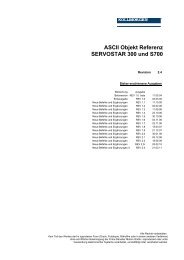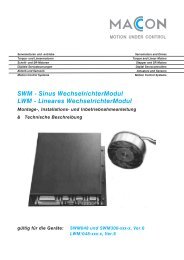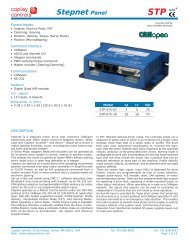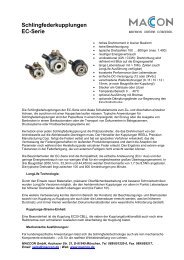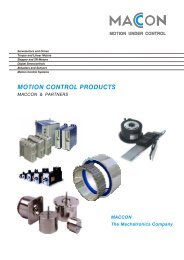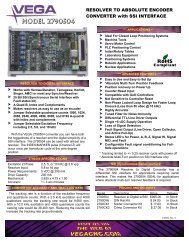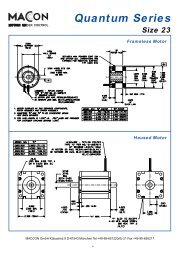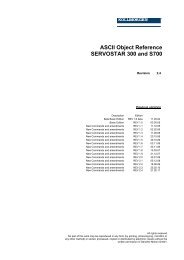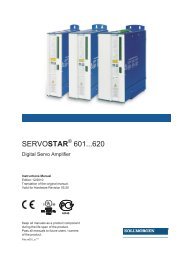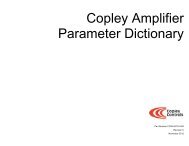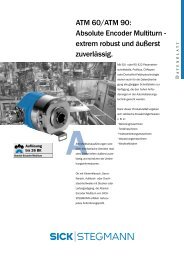CANopen Programmer's Manual - Maccon.de
CANopen Programmer's Manual - Maccon.de
CANopen Programmer's Manual - Maccon.de
You also want an ePaper? Increase the reach of your titles
YUMPU automatically turns print PDFs into web optimized ePapers that Google loves.
<strong>CANopen</strong> Programmer’s <strong>Manual</strong> 4: Control Loop Configuration<br />
Nested Position, Velocity, and Current Loops<br />
Nesting of Control Loops and Mo<strong>de</strong>s<br />
Copley Controls amplifiers use up to three nested control loops - current, velocity, and position - to<br />
control a motor in three associated operating mo<strong>de</strong>s.<br />
In position mo<strong>de</strong>, the amplifier uses all three loops. As shown in the typical system illustrated<br />
below, the position loop drives the nested velocity loop, which drives the nested current loop.<br />
Target<br />
Position<br />
Trajectory<br />
Generator<br />
Position<br />
Command<br />
Position<br />
Loop<br />
Actual Position<br />
Velocity<br />
Command<br />
Limits<br />
Velocity<br />
Limiter<br />
Limited<br />
Velocity<br />
FILTER<br />
Velocity<br />
Loop<br />
Derived Velocity<br />
Current<br />
Command<br />
Current<br />
Limiter<br />
Limited<br />
Current<br />
Actual Current<br />
PWM<br />
Command<br />
Copley Controls 129<br />
FILTER<br />
Current<br />
Loop<br />
Motor/<br />
Sensors<br />
In velocity mo<strong>de</strong>, the velocity loop drives the current loop. In current mo<strong>de</strong>, the current loop is<br />
driven directly by external or internal current commands.<br />
Basic Attributes of All Control Loops<br />
These loops (and servo control loops in general) share several common attributes:<br />
Loop Attribute Description<br />
Command input Every loop is given a value to which it will attempt to control. For example, the velocity loop<br />
receives a velocity command that is the <strong>de</strong>sired motor speed.<br />
Limits Limits are set on each loop to protect the motor and/or mechanical system.<br />
Feedback The nature of servo control loops is that they receive feedback from the <strong>de</strong>vice they are<br />
controlling. For example, the position loop uses the actual motor position as feedback.<br />
Gains These are constant values that are used in the mathematical equation of the servo loop. The<br />
values of these gains can be adjusted during amplifier setup to improve the loop<br />
performance. Adjusting these values is often referred to as tuning the loop.<br />
Output The loop generates a control signal. This signal can be used as the command signal to another<br />
control loop or the input to a power amplifier.




